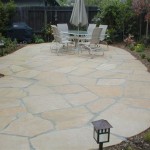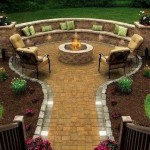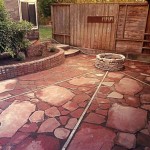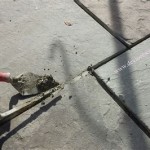Beautifying Your Patio With Pavers And Stones Together
Creating an aesthetically pleasing and functional patio space often involves selecting the right materials. Pavers and stones, both popular choices for outdoor flooring, offer distinct advantages and can be combined effectively to enhance the visual appeal and practicality of a patio. This article explores various techniques and considerations for integrating pavers and stones to achieve a beautiful and durable outdoor living area.
The selection of materials for a patio should be based on a variety of factors, including the intended use of the space, the overall design aesthetic of the property, and the budget. Pavers, typically manufactured from concrete or clay, are known for their uniformity in size, shape, and color. This consistency allows for precise installation and the creation of intricate patterns. Natural stones, on the other hand, offer a unique and organic look, with variations in color, texture, and size that contribute to a more rustic and natural ambiance. Combining these materials strategically can result in a patio that is both visually striking and functionally sound.
Prior to embarking on a patio beautification project, careful planning is essential. This planning phase should encompass the overall design concept, material selection, budgeting, and installation considerations. Accurate measurements of the patio area are crucial for determining the quantity of materials required and minimizing waste. Creating a detailed design plan, either on paper or using design software, allows for visualization of the finished product and facilitates adjustments before any physical work begins. Furthermore, it helps in estimating the overall cost of the project and identifying potential challenges.
Defining Zones and Creating Visual Interest
One effective way to combine pavers and stones is to use them to define distinct zones within the patio area. For example, pavers can be used to create a formal dining area, while natural stones can be incorporated into a more relaxed seating area. This zoning approach not only enhances the functionality of the space but also adds visual interest. The contrasting textures and colors of pavers and stones provide a natural separation, making each zone feel distinct and purposeful.
Consider using pavers for high-traffic areas, such as walkways or entry points, due to their durability and uniform surface. Natural stones, with their inherent texture and irregularity, can be incorporated into less frequently used areas, such as around a fire pit or as a decorative border. The strategic placement of these materials can guide the eye and create a more dynamic and engaging outdoor space. To further enhance the visual appeal, consider using different sizes and shapes of pavers and stones within each zone. For example, larger stones can be used as stepping stones within a gravel path, while smaller pavers can be arranged in intricate patterns to create a focal point.
The choice of colors and textures plays a significant role in creating a cohesive design. If the goal is to achieve a modern and minimalist look, opt for pavers and stones in neutral tones, such as gray, beige, or white. For a more rustic and natural aesthetic, consider using stones with earth tones, such as brown, tan, or terracotta, and pairing them with pavers that complement these colors. The juxtaposition of different textures can also add depth and dimension to the patio. Smooth pavers can be contrasted with rough-textured stones to create a tactile experience and visual interest.
Creating Borders and Accents
Pavers and stones can be used effectively to create borders and accents, enhancing the overall design of the patio. A paver border can frame a stone patio, providing a clean and defined edge. Conversely, a stone border can add a natural and organic touch to a paver patio. The choice of border material should complement the primary material used for the patio surface, creating a harmonious and visually appealing transition.
Accents can be incorporated throughout the patio to add visual interest and break up large expanses of a single material. Consider using stones as accents within a paver patio, or vice versa. For example, a small stone circle can be incorporated into a paver patio to serve as a focal point or to create a seating area around a fire pit. Similarly, pavers can be used as accents within a stone patio to define walkways or to create a more formal seating area. The placement of accents should be carefully considered to ensure that they are visually balanced and contribute to the overall design.
Grout is another important consideration when using pavers and stones together. The choice of grout color and material can significantly impact the overall look of the patio. For a seamless and uniform appearance, use a grout color that matches the primary material. For a more contrasting look, use a grout color that complements the materials used. The width of the grout lines can also affect the appearance of the patio. Wider grout lines can create a more rustic look, while narrower grout lines can create a more modern and refined look. Ensure the grout material is suitable for outdoor use and can withstand the elements.
Incorporating Functional Elements and Landscaping
Beyond aesthetics, the incorporation of functional elements is crucial for maximizing the usability and enjoyment of the patio. Consider integrating features such as seating areas, fire pits, outdoor kitchens, or water features. Pavers and stones can be used to define these areas and create a cohesive design. For example, a stone seating area can be incorporated into a paver patio to provide a comfortable and inviting space for relaxation. An outdoor kitchen can be built using pavers and stones to create a functional and aesthetically pleasing space for cooking and entertaining.
Landscaping plays a vital role in enhancing the beauty and functionality of the patio. Plants can be used to soften the edges of the patio, provide shade, and add color and texture. Consider using pavers and stones to create planting beds or to define pathways through the garden. The choice of plants should complement the overall design of the patio and the surrounding landscape. Native plants are often a good choice, as they are well-suited to the local climate and require less maintenance. Incorporating trees, shrubs, and flowers can transform the patio into a vibrant and inviting outdoor oasis.
Lighting is another important element to consider when beautifying a patio. Outdoor lighting can be used to create ambiance, highlight architectural features, and enhance safety. Consider using pavers or stones to create pathways lined with lights, or to illuminate seating areas and other focal points. The choice of lighting fixtures should complement the overall design of the patio and the surrounding landscape. Low-voltage lighting is a good option for outdoor use, as it is energy-efficient and safe. String lights, lanterns, and spotlights can be used to create a variety of lighting effects and transform the patio into a magical space at night.
Proper maintenance is essential for preserving the beauty and longevity of a patio constructed with pavers and stones. Regular cleaning is necessary to remove dirt, debris, and stains. A pressure washer can be used to clean pavers and stones, but it is important to use a low-pressure setting to avoid damaging the surface. Sealing pavers and stones can help to protect them from the elements and prevent staining. The frequency of sealing will depend on the type of material and the level of exposure to the elements. Regular inspections should be conducted to identify any cracks, loose stones, or other damage. Promptly repairing any damage will help to prevent further deterioration and extend the life of the patio.
Combining pavers and stones offers a multitude of design possibilities for creating a beautiful and functional patio. By carefully considering the materials, design, and installation, it is possible to create an outdoor space that reflects personal style and enhances the overall appeal of the property. The integration of functional elements, landscaping, and lighting further elevates the patio experience, creating a welcoming and enjoyable outdoor living area.

31 Paver Patio Ideas For Your Home

40 Patio Pavers Ideas Design For Paved Patios

22 Best Natural Stones Ideas For Patio Designs In 2024

9 Kinds Of Stone Paving Ideas To Beautify Your Yard

How To Install A Paver Patio Garden Gate

Ideas For Your Home In Nicolock Pavers Inspiration Gallery Garden Paving Patio Backyard Landscaping

Paver Patios Landscape Solutions Design

40 Patio Pavers Ideas Design For Paved Patios

Flagstone Patios How To Guide Paving Cost Diy Vs Contractor Install Mutualmaterials Com

How To Build A Paver Patio Young House Love
Related Posts








